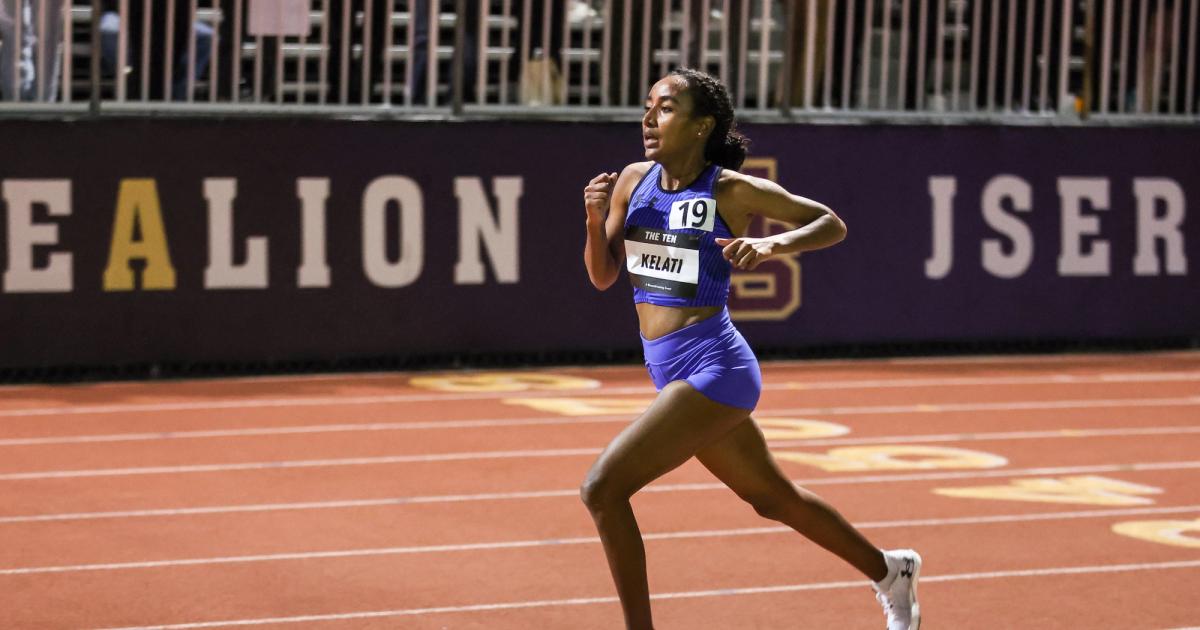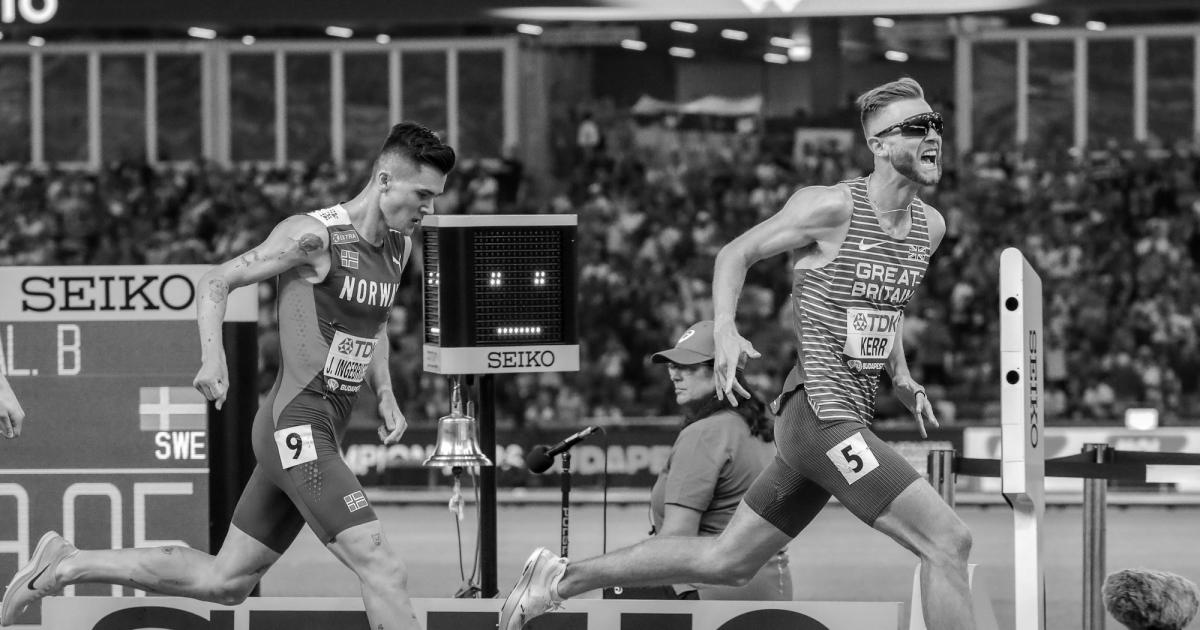By Kyle Merber
March 20, 2024
To be a distance running fan is to have a complicated relationship with the 10,000m. On one end of the spectrum, it is a beautiful symphony whose tempo gradually builds until its crescendo comes crashing down with the sound of the bell. We admire the will of the athletes as they find another gear within the depths of their souls.
And on the other, it’s a chaotic massacre with a plot more difficult to follow than that weird movie, Tenet.
Rest assured this dichotomy of the best and worst of the event was on full display Saturday night at The TEN.

Kevin Morris/@KevMoFoto
With a hot early pace set well ahead of the American record, the women’s race was blown up early. Within a few kilometers, it became difficult to follow who was who and who was where. Less than halfway through, Alicia Monson had fallen off the pace before dropping out due to stomach issues, leaving Tsigie Gebreselama upfront, pacer-less, to give her best effort in a now solo mission.
And despite all that she did well! Gebreselama still held on and once again knocked out the Olympic Standard of 30:40, winning in 29:48.34. Hopefully, the Ethiopian federation was paying its $30/month subscription to be able to watch, as every effort matters in what will inevitably be a super competitive team to make.
But behind her, it was a tough night to be a camera operator as the field was spread out for miles – or at least every inch of a full lap.
Chugging along behind Gebreselama were Weini Kelati, Lauren Ryan, and Megan Keith, who all achieved the Olympic Standard. Kelati and Monson are now the only two Americans with the standard, whereas Lauren Ryan is sitting pretty in Australia, and Megan Keith has to pray the British Athletics acts with some level of sanity – hardly a given.
Ryan is continuing an unbelievable progression in her second year as a professional, which now includes another national record. In January she ran the 5000m indoors in 15:15, and now two months later, she basically doubled the distance to post a 30:35.66. That’d be like if some 15-year-old kid went from running a 50-second quarter to being faster than David Rudisha. (This is a perfect analogy, please don’t critique it!)
Meanwhile, think about how impressed Americans are with Nico Young and that’s the equivalent of how the Brits are feeling about 21-year-old Megan Keith’s 30:36.84.
Only a few women unlocked a standard for themselves, but because this race was all over the place and difficult to follow, it wasn’t until afterward that it became apparent how well others ran. Less than 11 months after giving birth to her daughter, Nova, Rachel Smith ran a 38-second personal best of 31:04. After Haglund’s surgery this fall, Karissa Schweizer stepped up admirably in her first race back, going 31:04. Six weeks after dropping out of the Olympic Trials Marathon, Keira D’Amato went 31:05. And despite lung surgery in October, Ely Henes ran 31:07.
There are only two Americans with the Olympic standard, but their families shouldn’t book their accommodations in Paris just yet. That said, there aren’t many more real opportunities for others to qualify, assuming they’ll need the standard before the Trials. The best is probably the Night of the 10,000m PB’s, unless Hengelo or Prefontaine add something that has not yet been announced. Alternatively, these athletes could link up at Mt. SAC next month to try again, but it’ll take a coordinated effort. You aren’t getting this time alone.
And that’s the issue with the 10,000m — where can you find a good one? Or at least an okay one for a second attempt?
With the road to qualification also possible via the roads or the eight spots reserved from cross country, it seems like World Athletics needs to decide if they’re committing to this thing or not. The discipline as a whole can’t be entirely dependent on Sound Running deciding whether or not they should rent out a high school track once or twice a year.
From the standpoint of pure entertainment, the event should objectively not be included in a Diamond League main program. I like it a reasonable amount, particularly in championships, but even my mild ADHD occasionally kicks in with 17 laps to go.
Simultaneously, the need to go all-in on one singular attempt almost five months before the actual event is sucking the talent out of numerous other major events like World Indoors and XC.
For three cycles now, the Olympic standard has been raised (lowered?) considerably:
- 2024 - 27:00/30:40
- 2016 - 27:28/31:25
- 2012 - 28:00/32:15
At this point, there’s no room for error in a qualifying attempt, which forces athletes to sacrifice the remainder of their season to get it right on one day. Is this rewarding the behavior that the sport benefits from, namely racing hard, and often? To quote Grant Fisher’s post-race interview:
"I think anyone in this race would rather get 15th place in running 26:59, than win it in 27:01.” And he’s not wrong."
From any federation’s perspective, should the team competing in August be decided in March, or even earlier? There is a reality in which Alicia Monson would not have had to prove fitness since her American record run in March 2023. In this scenario, she could be named to the team – competing 17 months later – over someone who beats her the month before the Olympics.
There are two approaches to team selection:
- Individuals must unlock their spots.
- Federations collectively unlock spots.
The first, which is customary on the track and does not allow for the reallocation of spots, can be confusing in certain situations. For example, if Karissa Schweizer wins the Olympic Track Trials in 31:00 over Alicia Monson and Weini Kelati, she may not go.
But if the standards set have established that the women Schweizer beats are good enough, and she is better, then is she not good enough? That’s logic 101. In an ideal world, that second methodology is set up so that the top three at the Trials are always going. Except as we theorized a lot before the Olympic Marathon Trials for the men, there are plenty of worlds in which that doesn’t happen.
This sport shouldn’t be about running fast – it should be about running faster than everyone else. And while the standard keeps getting faster, beating others when it counts should be our North Star. Because if being top three at the Trials doesn’t get you to the Olympics, then isn’t the TEN the real Trials
Not the craziest idea…

Kyle Merber
After hanging up his spikes – but never his running shoes – Kyle pivoted to the media side of things, where he shares his enthusiasm, insights, and experiences with subscribers of The Lap Count newsletter, as well as viewers of CITIUS MAG live shows.




